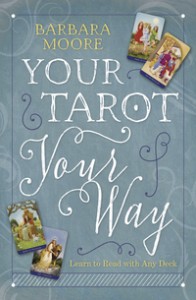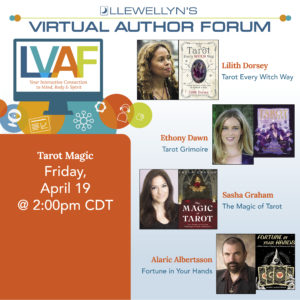Evolving Tarot
One of the main reasons people turn to tarot is because they want answers, clarity, and guidance. Driven by that need, we want to desperately prescribe absolutes to tarot: how it works, how we use it, and what the cards mean. However, I think clinging to that rigidity is counter to the spirit of tarot. Tarot is a tool that continues to fascinate us because it is flexible enough to adapt to changes in individual, social, and human consciousness.
Consequently, I believe the way we teach tarot should change. And that’s why I wrote Your Tarot Your Way. Below is an (unedited) excerpt from the first chapter explaining more about this idea.
It’s All About You
Everyone has basic questions about tarot, like “how does it work?” and “how do you know what the cards mean?” Here’s where tarot gets difficult. It’s not in learning to read the cards. It’s in trying to understand how tarot works. Here’s why that is the hard part: we are all looking for an answer, a clear, concise, undeniable truth answer. We think there is one universal truth behind these mysterious cards and if we can discover it, we will have access to the secrets of the universe. We read one book that says one thing and another that says something else and we think “so and so doesn’t know what he’s talking about!” We get hung up on trying to figure out the Capital T Truth. Or at least, that’s the way I felt when I started out. After all, if the cards are supposed to tell the future, they must have some rules for accessing that all-important information. The Capital T Truth is this: tarot has never been absolute…not in the way it looks or in the way it has been used. But if there is no original written-by-God-and-given-to Moses in stone Truth, it seems impossible to unlock the secrets that we think the cards hold. On the other hand, this realization makes everything easier. I’ll tell you why soon and as the chapter title says, it is all about you. But first let me prove my point about tarot never having been absolute.
Here is a Brief History of Tarot
In museums, we have remnants of a few tarot deck made in the 15th century, in Italy. The tarot cards that we now call the Major Arcana (in modern decks, these twenty-two cards are named and numbered) were not numbered. Tarot decks back then were handmade works of art, often full of luxurious gold leaf, and only the richest families had them. They were sometimes given as wedding gifts, with images of the bride and groom gracing some of the cards. The cards that we now call the Minor Arcana (in modern decks, these fifty-six cards are divided into four suits and include an ace – ten, Page, Knight, Queen, and King) had no scenes on them, just suit designators like modern playing cards (the one notable exception to this rule is the Sola Busca Tarot, which you will hear about again very soon).
When the printing press made printed items more affordable, the cards gained in popularity, and then lots of people played the game of tarot, also called tarocchi.
As is the case with games, tarot fell out of popularity for a few centuries until the 18th century, when a few people starting finding old decks. Because the cards were full of symbols, they decided that the cards were not just a game but had deeper allegorical meanings. These people began writing books about the meanings of the cards, sometimes claiming that the meanings came from ancient Egypt. Today we have no evidence that there is a solid Egyptian connection. This doesn’t mean there isn’t, and it is fun to imagine wild histories about the cards. However, strictly speaking, we can’t claim any Egyptian roots with any confidence.
During the Victorian-era when secret societies and occultism were all the rage, the cards were used in various secret societies to, well, hold the secrets. They were also used for divination and more “ancient” texts were “discovered” or at least referenced. We are pretty sure that most of these were invented and not discovered. During this time came one of the biggest changes in tarot. A man named Arthur Waite hired an artist named Pamela Coleman Smith to illustrate a tarot deck. They were both members of the Golden Dawn, one of the more popular Victorian-era secret societies. Arthur didn’t care much about the Minor Arcana and left a lot of the image design up to Pamela. She was influenced by that Sola Busca deck mentioned earlier and instead of using only suit designators, she painted images that reflected what the cards were said to mean.
What’s really interesting is that this deck, often called the Waite-Smith Tarot (although it was originally called the Rider-Waite Tarot…because Rider was the name of the company that published the deck), has come to dominate modern tarot, especially in America. Most tarot experts say it is the best deck with the most authentic symbols and meanings. And most tarot decks that are popular these days (including the one you just bought!) are modeled after the Waite-Smith Tarot. In recent decades, there have been many books published about the symbols used in these particular cards, analyzing everything. For example, the number of lines forming the rays of the sun in the Sun card was thought to be meaningful but a closer examination of the printing history shows that the number of lines changed in the earliest printings because one of the plates used to print the cards cracked, creating an extra “ray.” Further, in the spring of 2015 a book called The Secrets of the Waite-Smith Tarot by Marcus Katz and Tali Goodwin shows that so many of the symbols come from somewhere other than where we thought (such as a great many are from Shakespeare and some simply from the summer cottage where Pamela lived while painting the deck).
Despite the symbols not necessarily meaning what we thought or why we thought, for over a century people have used this deck (and ones like it) to great effect. Symbols are powerful things and they get so much of there meaning from the society from which they emerge and also from the individual looking at them. Finding meaning in a symbol is actually a very active experience based on innate archetypal recognition, cultural environment, and personal experience. It is not necessary to go back in time to some mythical age where the cards fell to earth fully formed and with precise and unchangeable meanings. The tarot cards are sometimes called “keys.” They are keys that open doors and behind those doors are worlds of meaning, some of which don’t even exist until you walk through. I think of it as being like those scientific theories that explain how the observer affects the thing that is being studied.
Other changes happened to the cards, beginning with Pamela and her charming paintings. The Major Arcana cards became numbered (and order in which these cards were numbered caused and continues to cause much debate among tarot experts). Images changed radically. For example, in the earliest decks, the Fool looked like a crazy person (or perhaps like a mentally-challenged person), often with his pants falling off and his rear end (and sometimes even his genitals!) hanging out with a dog trying to bite it. Today, the Fool is shown as a pure soul about to incarnate into this plane of existence. Also, in earlier books, the meanings of the cards seemed arbitrary and didn’t necessarily reflect the image on the card, which meant the image was merely decorative and not meant to be interpreted. This is very different from today, where it is almost more common to read the image rather than refer to any sort of esoteric meaning.
For a long time, tarot was used to tell fortunes. This is probably still one of the most common uses for it today, because, really, who doesn’t want to know the future? However, even this has changed. Before the later twentieth century, people had a much more deterministic or fatalistic view of the world. Depending on where you were born, what class you were born to, and what gender you were, it was not too difficult to “predict” your future because it wasn’t like you had a lot of choices. Today, we are more of a “you make your own future” people. We believe not just in free will but in the ability to do or achieve whatever we want. So the idea of telling the future changes, because the future is not set in stone.
Tarot is now also used for other things, such as creative writing, journaling, magical work, and brainstorming. Because of his notion of synchronicity and interest in symbols, many tarot readers are fans of Carl Jung. His work has influenced the direction of modern tarot. In fact, some psychologists incorporate tarot into their work with patients. Each year in New York, there is a conference about Tarot and Psychology, a clear indication of the level of interest among psychology professionals.
Besides new uses, there are more decks than ever before with all sorts of artwork and themes. Some of these break with the Waite-Smith tradition and create new ways of exploring what tarot can be. Oh, and in parts of Europe, you can still watch locals buy a pack of tarot cards at the corner tobacconist’s shop and play a game with a friend at the local café.
Maybe that wasn’t as brief as I led you to believe. The history of tarot is a lot longer and very interesting. If you want to know more, check out Robert Place’s The Fool’s Journey: The History, Art, and Symbolism of the Tarot or Mary K. Greer’s blog at https://marygreer.wordpress.com.
I know that not everyone cares about history and you really don’t need to know the history to read the cards. It is, though, important to understand at least this very basic timeline because this is how we know that there is no full and complete Capital T Truth. This, it turns out, is actually great for you because it means becoming a reader has become easier. This means that everything about the tarot, everything about what you will do with the cards and how they will work in your hands, is determined by no one but you. Your use of the tarot cards should reflect your beliefs…about how the world works, about spiritual ideas, about what your role on this planet is, to name just a few. You might need some help in translating your beliefs into tarot principles, but I’m here to help with that. To get started, let’s gather some data about you. Hurray! This is our first recess period!











Great article. An interesting read about the history. I love that the Waite-Smith tarot is now named for the artist as well.
[…] On the evolution of tarot. […]